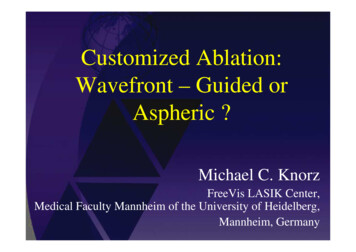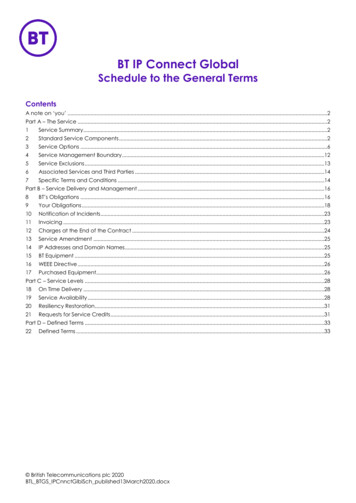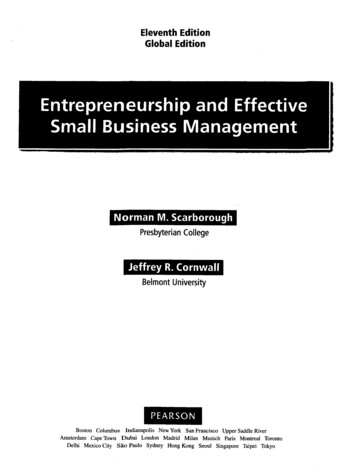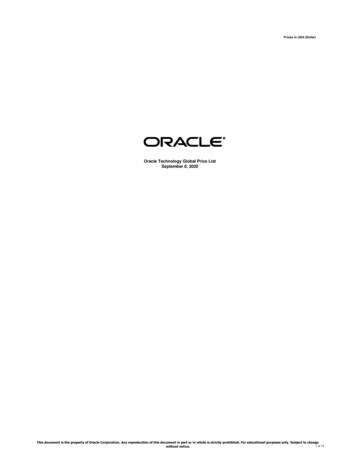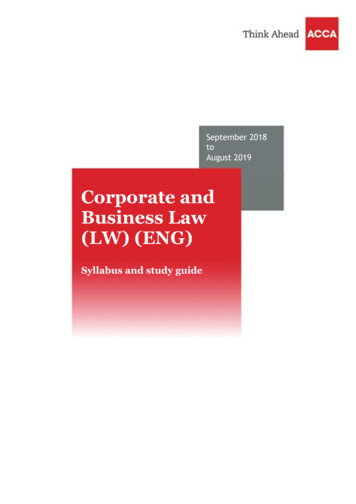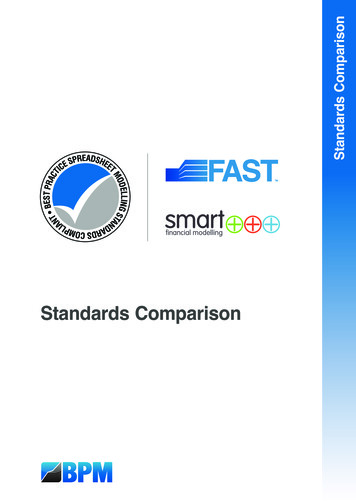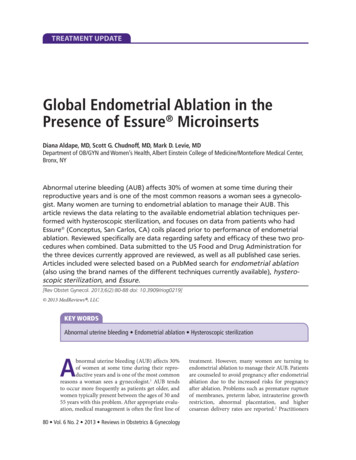
Transcription
TreaTmenT UpdaTeGlobal Endometrial Ablation in thePresence of Essure MicroinsertsDiana Aldape, MD, Scott G. Chudnoff, MD, Mark D. Levie, MDDepartment of OB/GYN and Women’s Health, Albert Einstein College of Medicine/Montefiore Medical Center,Bronx, NYAbnormal uterine bleeding (AUB) affects 30% of women at some time during theirreproductive years and is one of the most common reasons a woman sees a gynecologist. Many women are turning to endometrial ablation to manage their AUB. Thisarticle reviews the data relating to the available endometrial ablation techniques performed with hysteroscopic sterilization, and focuses on data from patients who hadEssure (Conceptus, San Carlos, CA) coils placed prior to performance of endometrialablation. Reviewed specifically are data regarding safety and efficacy of these two procedures when combined. Data submitted to the US Food and Drug Administration forthe three devices currently approved are reviewed, as well as all published case series.Articles included were selected based on a PubMed search for endometrial ablation(also using the brand names of the different techniques currently available), hysteroscopic sterilization, and Essure.[ Rev Obstet Gynecol. 2013;6(2):80-88 doi: 10.3909/riog0219] 2013 MedReviews , LLCKey wordsAbnormal uterine bleeding Endometrial ablation Hysteroscopic sterilizationAbnormal uterine bleeding (AUB) affects 30%of women at some time during their reproductive years and is one of the most commonreasons a woman sees a gynecologist.1 AUB tendsto occur more frequently as patients get older, andwomen typically present between the ages of 30 and55 years with this problem. After appropriate evaluation, medical management is often the first line oftreatment. However, many women are turning toendometrial ablation to manage their AUB. Patientsare counseled to avoid pregnancy after endometrialablation due to the increased risks for pregnancyafter ablation. Problems such as premature ruptureof membranes, preterm labor, intrauterine growthrestriction, abnormal placentation, and highercesarean delivery rates are reported.2 Practitioners80 Vol. 6 No. 2 2013 Reviews in Obstetrics & Gynecology4170005 RIOG0219.indd 8026/09/13 4:47 PM
Global Endometrial Ablation in the Presence of Essure Microinsertsmust offer a reliable contraceptivemethod after endometrial ablationhas been performed.2There is a higher prevalence ofwomen choosing permanent sterilization for their contraception asthey age. According to the 20062008 National Survey of FamilyGrowth, 28.2% of women aged 35to 39 years and 39.1% of womenaged 40 to 44 years use female sterilization as their choice of birthcontrol.3 Ideally, women requiringterpathalate material. Proper placement of the Essure coils requires 3to 8 coils to be in the endometrialcavity,4 which puts the microinsertin direct or indirect contact withthe ablation device. Some concernsthat need to be evaluated include1. Thermal and/or ElectricalConductivity Given that the coils usedin hysteroscopic sterilizationare made out of metal, does 28.2% of women aged 35 to 39 years and 39.1% of women aged40 to 44 years use female sterilization as their choice of birth control.endometrial ablation could benefitfrom concomitant procedures providing relief of their menorrhagiaas well as permanent birth control. The transcervical approachof endometrial ablation and hysteroscopic sterilization makes thetwo methods well suited to be performed simultaneously, providingboth menorrhagia relief and permanent sterilization. Furthermore,the second-generation endometrialablation methods and hysteroscopicsterilization can both be performedin an office setting with local anesthetics and minimal anesthesia.CurrentlytheNovaSure (Hologic, Bedford, MA), hydrothermal ablation (HTA), andGynecare ThermaChoice (Ethicon,Somerville, NJ) are third-generationmethods of global endometrial ablation (GEA) that are approved by theUS Food and Drug Administration(FDA) for use with Essure (Conceptus, San Carlos, CA) coilsin situ. In consideration of performing a concomitant endometrial ablation with Essure coils in situ, severalconcerns regarding safety and efficacy need to be addressed.Hysteroscopic sterilization requires placement of a microinsertthat spans the uterotubal junction. This coil is made up of stainless steel, nitinol, and polyethylthe microinsert transmit theheat or conduct energy that isgenerated during endometrialablation distally to the tube oroutside the uterus? What is the extent of damage that may occur due to thisincrease in temperature orenergy transmission? Most importantly, is the ability of the microinsert to yieldtubal occlusion affected by itsexposure to these conditions?2. Tubal Occlusion ConfirmationTesting A confirmation of tubalocclusion prior to proceeding with endometrial ablationis currently recommendedby the FDA.4 Although concomitant use of GynecareThermaChoice with Essurecoils was granted by the FDAin 2006, this was rescindedafter several patients hadinadequatehysterosalpingogram (HSG) proceduresdue to Asherman syndrome.Therefore, how does ablationaffect the ability to performthe confirmation test? If the ability to perform HSGis compromised, are therealternatives to this confirmatory test that are acceptable?Bipolar RadiofrequencyAblationBipolar radiofrequency ablation(NovaSure) uses a bipolar mesharray that delivers radiofrequencyelectrical current to the endometrial surface until an impedance of50 of resistance is obtained.5 InFebruary 2012, the FDA changedthe Essure package labeling to read“NovaSure Impedance ControlledEndometrial Ablation System canbe safely performed with the Essuremicro-insert in place.”6 This wasbased on bench and clinical studiesthat are outlined below.Hysterectomy StudiesCoad and colleagues7 looked atwomen previously scheduled forhysterectomy for benign conditionswho underwent unilateral Essuremicroinsert placement immediately followed by NovaSure ablation (n 5 13), with the contralateraltube serving as a control. Thermalimaging was used to monitor surface temperatures during the ablation portion of the procedure. Theuteri were stained for thermal fallopian tube injury and endomyometrial injury immediately followinghysterectomy. Placement of themicroinserts with subsequent ablation was accomplished withoutclinical difficulty. The mean serosal temperature during the ablationportion was , 44 C and was similar between the microinsert andcontrol tubes. The mean thermalablation depths were not alteredby the microinserts. No controltubes showed thermal injury. Fourmicroinsert tubes showed thermalinjury within the interstitia (n 5 3)and interstitial/isthmic (n 5 1) segments with a mean depth of 0.4 mm.This tubal injury had a decreasingproximal to distal injury gradient.No serosal injury was identified.7Garza-Lealandassociates8studied 13 women undergoingVol. 6 No. 2 2013 Reviews in Obstetrics & Gynecology 814170005 RIOG0219.indd 8126/09/13 4:47 PM
Global Endometrial Ablation in the Presence of Essure Microinserts continuedabdominalhysterectomyforAUB. Patients underwent proximal microinsert placement inone fallopian tube and the contralateral tube served as a control. During NovaSure ablation,thermal imaging monitored serosal temperatures. The specimenswere stained for thermal injury tothe tubes and intrauterine cavity.During the NovaSure procedure,the mean serosal temperature was, 40 C and was similar betweenthe microinsert and controltubes. The microinsert did notsignificantly alter the mean cornua maximum thermal injurydepths (implanted 6.3 6 1.7 mmand nonimplanted 6.3 6 1.1 mm;P 5 .989). The minimum cornuathermal injury to uterine serosal distance was similar for the implantedand nonimplanted cornua (15.0 67.7 mm vs 15.2 6 7.9 mm; P 5 .382).Three implanted fallopian tubesshowed thermal injury within theinterstitial. One tube showed thermal injury within the interstitial/isthmic (n 5 1) segments. This thermal injury was confined to the myometrium and had a mean depth of1.1 mm and focally extended within0.7 mm of the serosa. The degree ofthermal injury was noted to have adecreasing proximal to distal gradient. No primary serosal thermalinjury arising from the microinserts was noted. No thermal injurywas identified in the control tubes.8In another study by Coad andcolleagues9, six patients underwent bilateral Essure placement,a confirmatory test by HSG at 90days, and endometrial ablationwith NovaSure, followed by hysterectomy 5 days later. The uteriwere stained for viability to evaluate the extent of NovaSure ablation. The uteri showed completeor eccentric partial cornual ablation. Maximum viability-negativeendomyometrial ablation was6.3 6 1.6 mm. The closest serosaldistance from NovaSure ablationwas 10.1 6 4.3 mm with the minimum being 3.6 mm; 10 microinsertsshowed hyperthermic tissue thermal necrosis within the cornual,tubal os, and/or proximal interstitial fallopian tube (regional overlapwith NovaSure ablation). None of10 microinserts showed in-growthnecrosis in the distal interstitialand/or isthmic tubal regions; twomicroinserts showed no thermal ingrowth necrosis at any location.Case SeriesIn a retrospective cohort study byBasinski and Price,10 117 patientsunderwent Essure placement followed by NovaSure in two separate office settings; 83 patients(71%) returned for a 3-month HSG.Satisfactory placement of Essurecoils and tubal occlusion on theHSG was noted in 95% of patients.There were no reported adverseeffects. Patients were evaluated forsatisfaction of procedure througha questionnaire that they filled outat the time of HSG; 74% reportedamenorrhea and/or vaginal spotting, 23% reported only decreasein menstrual flow, and 3% reportedablation failure. The authors concluded that subsequent NovaSureafter Essure did not decrease theeffectiveness of either procedure.Immerzeel and associates11 conducted a study to evaluate ultrasound as confirmatory test afterEssure sterilization followed byimmediate NovaSure ablation.Fifteen patients were assigned toEssure sterilization followed byimmediate NovaSure ablation ifplacement of Essure was considereduncomplicated. Twelve patientshad uncomplicated Essure procedures followed by NovaSure ablation and ultrasound at 3 monthsto confirm proper placement. Onecase was complicated by accidental removal of a microinsert withremoval of the NovaSure probe.The microinsert was replaced successfully. This patient underwent asuccessful HSG at 3 months, whichconfirmed proper coil placement.Three other patients required HSGdue to the course of the procedureand all underwent successful ablation after the confirmatory test.A retrospective chart review of10 cases performed by Kulbersh12evaluated the placement ofEssure followed by NovaSure ablation. Patients underwent bilateralEssure placement followed byNovaSure in the same surgicalsession. Bilateral microinsert placement was achieved in all of thepatients. Microinsert placementwas confirmed by ultrasound at3 months.Long-term Follow-upIn the study by Basinski and Price,10patients were followed for contraceptive and endometrial ablationeffectiveness. Out of 117 patients,97 completed a questionnaire onsatisfaction of results and contraception. All patients were “satisfied” or “very satisfied” with theprocedure. All patients were relying on Essure for contraceptionwith no reported pregnancies. Inthe study by Kulbersh,12 one patientunderwent total abdominal hysterectomy with bilateral salpingooopherectomy 1 year postablationsecondary to persistent bleedingand a large fibroid.Thermal Balloon AblationIn thermal ablation techniques(GynecareThermaChoice,TM[PnnMedical SA,CavatermMorges, Switzerland], ThermablateEASTM [Idoman Ltd, Dublin,Ireland]), a silicone balloon isinserted into the uterine cavitythrough a probe and isexpanded with either 5% dextroseinwater(GynecareThermaChoice, Cavaterm) or82 Vol. 6 No. 2 2013 Reviews in Obstetrics & Gynecology4170005 RIOG0219.indd 8226/09/13 4:47 PM
Global Endometrial Ablation in the Presence of Essure Microinsertsglycerin (Thermablate EAS). Thefluid reaches temperatures ranging from 78 C to 173 C.13 Unlikethe NovaSure, with which there isdual concern for electrical and thermal spread to the microinsert, withthese techniques the only concernis thermal injury to adjacent structures. There is also a potential riskfor balloon rupture by the tubalmicroinserts.Hysterectomy StudiesValle and coauthors14 conducted astudy of 40 patients. The study wasdivided into a feasibility arm and asafety arm. In the feasibility arm,16 women underwent placementof Essure followed by immediateGynecare ThermaChoice ablation.In the safety study, seven patientshad temperature sensors placedunder the tubal serosa to assess heattransmission from the intratubalinsert devices to the surrounding organs during ablation. Thefeasibility arm of the study evaluated the completeness of endometrial ablation and possible devicedislodgement. The safety studylooked at temperature readings.Microinserts were not disturbedduring the ablation. Ablation wasnoted to be complete visually andhistologically, although small areasnear the tubal ostia showed lessendometrial destruction. Meantubal temperatures ranged from37.1 C to 37.5 C. No damage to thetubes was noted.14Case SeriesDonnadieu and colleagues15 andDonnadieu and Fernandez16 studied 23 women with AUB whodesired permanent tubal sterilization. Patients were treatedwith combined Essure placement and endometrial ablation.Eleven patients underwent Essureplacement followed by GynecareThermaChoice ablation. Patientswere followed for 4 to 26 monthswith no reported pregnancies; 85%of patients reported satisfactionwith the outcomes. In one study byVilos and colleagues,17 80 patientsunderwent Essure placement priorto or after Thermablate EAS ablation. Of these, nine women underwent Essure placement followedby Thermablate EAS endometrialablation. There were no complications noted. All microinsertswere placed successfully and at3 months one tube was patent. At3 to 12 months follow-up, 30% ofpatients reported amenorrhea, 50%reported spotting or hypomenorrhea, 7% reported eumenorrhea,and 10% reported menorrhagia. Theoverall satisfaction rate was 85%.Donnadieu and associates18 conducted a retrospective study inwhich 12 women underwent Essurecornua of the uterus and the tipof a normal-appearing appendix.Microinserts were located in thecenter of each abscess. Cultureswere positive for Haemophilusinfluenzae. On histology there waschronic inflammation and fibrosis and the appendix was infectedand contained a small intraluminal abscess. The patient recoveredwithout further complications.The authors discuss the possibilityof asymptomatic endometritis andconsequent bilateral abscess formation at the site of foreign bodiesafter the endometrial ablation.Hydrothermal AblationHTA is performed by placing a hysteroscope into the uterine cavityunder direct visualization; heatedisotonic saline is then circulatedHTA is performed by placing a hysteroscope into the uterine cavityunder direct visualization; heated isotonic saline is then circulatedinto the cavity using gravity.placement immediately beforeGynecare ThermaChoice ablation.At 3 months, proper positioning ofthe microinserts was confirmed bycontrast three-dimensional ultrasound in all women. No pregnancies were reported at 18-monthfollow-up.ComplicationsIn a case report by Jansen and colleagues19 and Del Pozo and Gómez20from 2007, the authors describe apatient with Essure microinserts insitu who was treated by thermal balloon ablation 9 months after Essureplacement for AUB. Three monthsafter the ablation, the patient developed bilateral cornual abscesses.She was treated with doxycyclineand metronidazole and underwenta laparotomy with bilateral salpingectomy and appendectomy. Onlaparotomy bilateral abscesses werenoted in both intramural parts ofthe tubes, which extended to theinto the cavity using gravity.21 Thecirculating fluid reaches temperatures of 90oC, which can potentiallycause thermal injury to surrounding structures if there is leakage offluid.Prehysterectomy StudiesCoad and colleagues9 looked atseven women previously scheduled for hysterectomy for benignconditions who underwent unilateral Essure microinsert placementimmediately followed by HydroThermAblator (Boston Scientific,Natick, MA). The contralateraltubes served as controls. Duringendometrial ablation, thermalimaging monitored serosal temperatures. Following immediate hysterectomy, the uteri were stainedfor thermal fallopian tube injuryand adjacent endomyometrial ablation. Mean serosal temperaturesduring endometrial ablation were, 44 C and were similar betweenVol. 6 No. 2 2013 Reviews in Obstetrics & Gynecology 834170005 RIOG0219.indd 8326/09/13 4:47 PM
Global Endometrial Ablation in the Presence of Essure Microinserts continuedthe microinsert and control tubes.In comparison with control tubes,the microinserts did not alter themean thermal ablation depths.None of the tubes with microinsertsshowed thermal injury. Three control tubes showed thermal injuryin the interstitial (n 5 1), interstitial/isthmic (n 5 1), or interstitial/isthmic/proximal ampullary (n 5 1)segments with a mean depth of0.4 mm. The tubal injury showeda decreasing gradient from proximal to distal. No serosal injury wasidentified. In a study by Dhainaut,22four patients had Essure placementfollowed by immediate HTA procedure. One patient who had plannedfor hysterectomy underwent theHTA procedure, after which adetailed histologic study was performed. On histology, the processof coagulation was limited to themucous membrane without reaching the muscularis of the fallopiantube.Hysterectomy StudiesSeven women undergoing abdominal hysterectomy for AUB underwentproximalmicroinsertplacement in one fallopian tube;the contralateral tube served as acontrol. Thermal imaging monitored serosal temperatures duringablation. The uteri were stainedfor thermal injury to the tubesand the extent of endomyometrialablation. Microinsert placementwith subsequent HTA was accomplished without clinical difficulty.Mean serosal temperatures duringablation were all , 44 C. No leakage was noted from the fallopiantubes. The microinsert did not significantly alter the mean thermalablation depths (implanted cornua3.6 6 1.1 mm; nonimplanted cornua 4.0 6 2.2 mm; P 5 .346). Theminimum cornua thermal injury touterine serosal distance was similarbetween the implanted and nonimplanted cornua (15.6 6 5.3 mmvs 15.7 6 5.5 mm; P 5 .866). Noimplanted fallopian tubes showedthermal injury after ablation. Threecontrol tubes showed proximalthermal injury with a maximumradial depth of 0.5 mm. Therewas no serosal injury noted. Thethermal injury of one control tubeextended to within 1.0 mm of theserosa.23Microwave AblationDuringmicrowaveablation(Acculis MTA; Microsulis Medical,Denmead, England) the microwave probe is placed in the uterinecavity to generate temperaturesof . 60 C at a depth of 6 mm.24Prior to its approval in the UnitedStates, there were reported casestube cross sections from the uterine tubal junction, midtube, anddistal tube locations were stainedfor regions of cellular devitalization. No significant increase infallopian tube injury was noted.Only the expected degree of ablation was noted in the intrauterinecavity.25Cryotherapy AblationThe technique of cryotherapyablation (Her Option ; CooperSurgical, Trumbull, CT) consistsof a cryoprobe that is placed in theuterine cavity and is cooled by liquid nitrogen. Using ultrasound,probe placement and depth of tissue destruction are monitored. Nostudies were found that describeThe technique of cryotherapy ablation consists of a cryoprobe thatis placed in the uterine cavity and is cooled by liquid nitrogen.of thermal bowel injury; therefore,the FDA requires a minimum of 1cm of myometrial thickness. Thisthermal injury can potentially happen with all endometrial ablationdevices.Hysterectomy StudiesTen wome
Essure followed by NovaSure abla-tion. Patients underwent bilateral Essure placement followed by NovaSure in the same surgical session. Bilateral microinsert place-ment was achieved in all of the patients. Microinsert placement was confirmed by ultrasound at 3 months.

